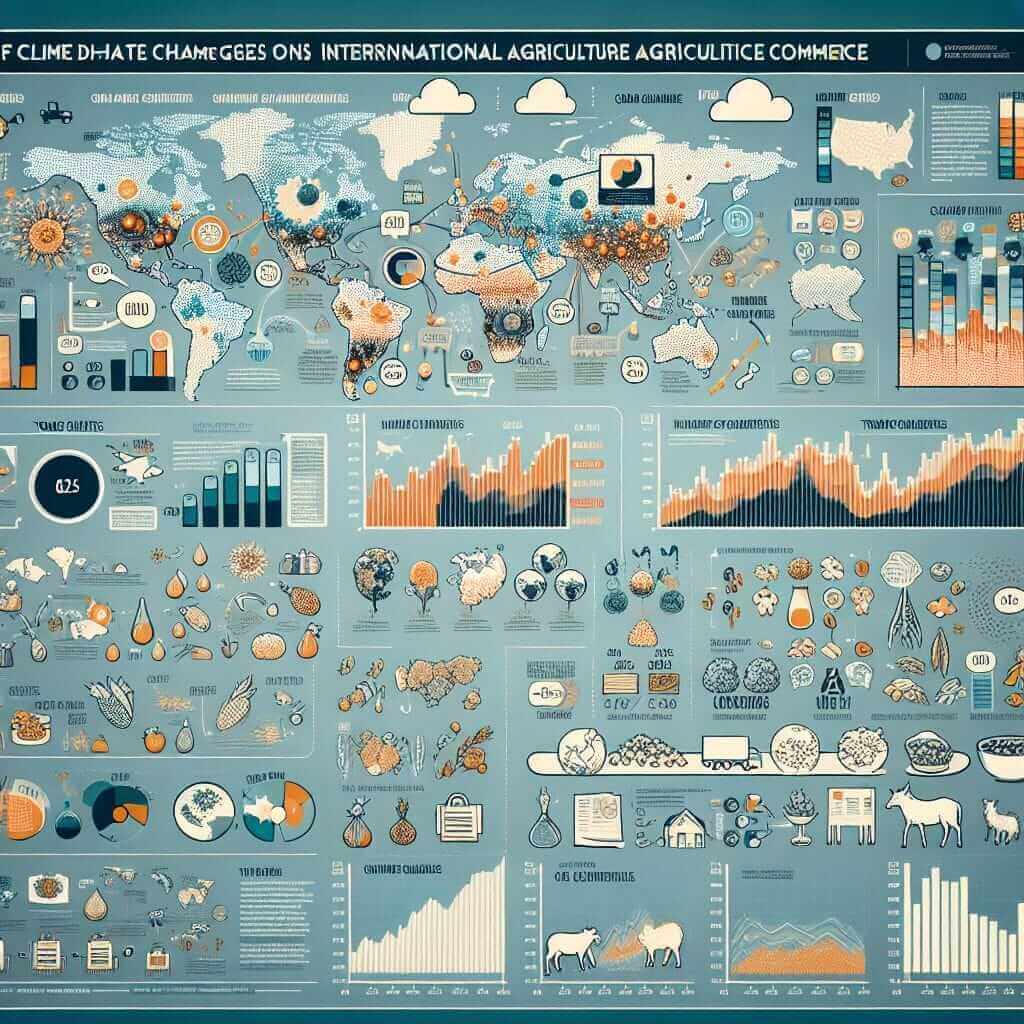The IELTS Reading test requires candidates to absorb, interpret, and critically analyze an array of texts under time constraints. One topic that has recurrently surfaced in past exams is climate change and its wide-reaching consequences. Considering its ongoing relevance, it is not far-fetched to expect similar topics in future tests. This article provides an in-depth reading practice exam centered on a particularly pressing issue: “What are the impacts of climate change on global agricultural trade?”
Practice Test: Reading Examination
Reading Passage: The Impacts of Climate Change on Global Agricultural Trade
Format: Hard Text
As the situation of global agriculture evolves, the connection between climate change and agricultural trade has become an area of intense scrutiny. This passage will go through various points detailing the impacts of climate change on global agricultural trade.
 Impacts of climate change on agriculture trade
Impacts of climate change on agriculture trade
Climate change presents multifaceted challenges for global agricultural trade, which could manifest through disruptions in crop production, changes in trade patterns, and alterations in market dynamics. The Intergovernmental Panel on Climate Change (IPCC) has reported that rising temperatures, altered precipitation patterns, and increased frequency of extreme weather events are likely to result in significant shifts in crop yields and agricultural productivity. For instance, staples like wheat and corn might see increased yields in higher-latitude regions due to prolonged growing seasons, whereas tropical regions might experience a decline in productivity due to heat stress and water scarcity.
One notable consequence of climate change is the geographical redistribution of agricultural production. Regions that were previously unfavorable for crop production might become more suitable, while traditionally fertile areas might suffer due to harsh climatic conditions. Consequently, countries might need to alter their trade strategies to adapt to these shifts, potentially increasing reliance on agricultural imports or adjusting export portfolios.
Moreover, the impact on trade extends beyond just crop yields. The quality and nutritional value of agricultural products could also be affected. Altered growing conditions might result in crops with varied nutrient compositions, making certain commodities less desirable in the global market. This, in turn, influences supply chains and trade agreements.
The cost of adaptation measures also plays a crucial role. Developing countries, which are often heavily dependent on agriculture, might struggle to bear the financial burden required to implement climate-resilient farming practices and infrastructure. Such economic disparities could exacerbate existing inequalities in global agricultural trade, posing ethical and policy challenges for the international community.
In addition, climate change could incite the establishment of new trade policies and agreements. Governments might impose tariffs, subsidies, or trade restrictions based on the evolving agricultural landscape. International cooperation through treaties and organizations will be imperative to mitigate and manage the effects of climate change on agricultural trade effectively.
Questions:
Multiple Choice
-
According to the passage, what is one of the primary challenges that climate change poses to global agricultural trade?
- A. Increased use of traditional farming methods
- B. Financial burden of adaptation measures
- C. Decrease in food variety
- D. Increase in global trade restrictions
-
Climate change can cause a geographical redistribution of agricultural production by:
- A. Making previously unsuitable regions more habitable for crops
- B. Increasing soil fertility in traditional farming areas
- C. Shortening growing seasons in all parts of the world
- D. Uniformly increasing global crop yields
True/False/Not Given
- Altered precipitation patterns and extreme weather events have a direct impact on agricultural productivity.
- All countries will benefit equally from the changes in agricultural trade caused by climate change.
- The quality and nutritional value of crops do not change as a result of climate change.
Matching Information
Match the following statements with the corresponding details in the passage:
- Redistribution of agricultural production _____
- Financial burden on developing countries _____
- Influence on international trade policies _____
a. Could result in an increase in tariffs and subsidies.
b. Regions previously unsuited for farming might become viable.
c. Struggle to implement climate-resilient practices and infrastructure.
Answer Key:
Multiple Choice
-
B. Financial burden of adaptation measures – The passage details how developing countries might struggle to bear the financial burden required to implement climate-resilient farming practices.
-
A. Making previously unsuitable regions more habitable for crops – The passage explains that regions previously unfavorable for crop production might become more suitable due to climate change.
True/False/Not Given
- True – The passage states that altered precipitation patterns and extreme weather events are likely to result in significant shifts in crop yields and agricultural productivity.
- False – The passage mentions that developing countries might struggle more with the financial burden, indicating that not all countries will benefit equally.
- False – The passage explicitly mentions that the quality and nutritional value of agricultural products could be affected by altered growing conditions.
Matching Information
- Redistribution of agricultural production – b. Regions previously unsuited for farming might become viable.
- Financial burden on developing countries – c. Struggle to implement climate-resilient practices and infrastructure.
- Influence on international trade policies – a. Could result in an increase in tariffs and subsidies.
Common Mistakes
- Misreading questions: Ensure to read each question carefully and understand what is being asked.
- Time management: Allocate your time wisely between reading the passage and answering the questions.
- Ignoring context clues: Sometimes, the answer might not be directly stated but inferred through context.
Vocabulary
- Multifaceted (adj.) – /ˌmʌlt.iˈfæs.ɪ.tɪd/ – Having many aspects or sides.
- Redistribution (n.) – /ˌriː.dɪs.trɪˈbjuː.ʃən/ – Distribution of something in a different way.
- Nutrient composition (n.) – /ˈnjuː.tri.ənt ˌkɒm.pəˈzɪʃ.ən/ – The makeup of nutrients in a substance.
Grammar Focus
-
Causal clauses: These clauses explain why something happens and are useful for explaining the effects of climate change.
- Structure: Because/Since/As + Subject + Verb
- Example: Since climate change affects rainfall patterns, agricultural productivity is impacted.
-
Conditional clauses: Useful for discussing potential scenarios.
- Structure: If + Present Simple, Subject + Will + Base Verb
- Example: If global temperatures rise, northern regions might see increased crop yields.
Conclusion
Achieving a high score in the IELTS Reading test requires practice, strategy, and comprehension skills. Consistently practicing with passages on relevant topics, such as climate change and its impacts on global agricultural trade, can prepare you effectively for the test. Remember to focus on understanding the text, manage your time wisely, and familiarize yourself with various question formats. Good luck with your preparation!


